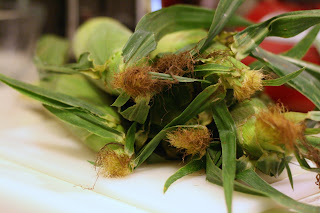I'm always on the lookout for good vegetarian dishes, for health reasons, and because I want to reduce my carbon footprint by reducing the amount of meat I consume. But it's more than just trying to do good by my body and my planet-I love vegetables! There are a lot of soy burgers out there, but I like veggie burgers that taste like vegetables, not try to imitate meat. I'm a dedicated NPR geek, and one of my favorite shows is The Splendid Table, where I got this recipe. I'm also a cookbook collector, and after making these delicious burgers from Veggie Burgers Every Which Way
I divided this recipe into four burgers instead of five, because I was cooking for two and this makes a dinner and lunch with no leftovers. This recipe says to transfer the burgers to the oven to bake, but doesn't give a temperature. I baked my burgers at 350 degrees F for between 10 and 12 minutes, although I suspect my oven may run a bit hotter than the temperature I set it to. You want to make sure the egg is thoroughly cooked and the burgers are set, and there is more than one set of baking conditions that can accomplish that, so just keep an eye on them as the bake in the oven.
Spinach-Chickpea Burgers
from The Splendid Table, who excerpted it from Veggie Burgers Every Which Way
Makes five 4-inch burgers
This is one of my favorite veggie burgers. It has everything I want: hearty chickpeas, fortifying spinach, a hint of nutty toasted cumin seeds, and final finish of fresh lemon. It’s also very easy! As with most burgers in this book, be sure to reserve a portion of the beans and mash them by hand, rather than blitzing all of them in the food processor, as this gives the burger texture. I like to serve them accompanied by traditional burger fixings: lettuce, tomato, and mustard.
2 tablespoons plus 1 teaspoon olive oil
1 teaspoon toasted cumin seeds
5 ounces fresh spinach
1 1/2 cups cooked chickpeas
2 eggs
Juice of 1/2 lemon
1 teaspoon salt
1/3 cup chickpea flour (see note), or more if needed
1. Heat 1 teaspoon of the oil in a medium skillet. Add the cumin seeds and spinach and cook, tossing with tongs, until the spinach is completely wilted, 2 or 3 minutes. Transfer to a heatproof plate and allow to cool until safe to handle. Drain if necessary, wrap in a towel, and squeeze out as much liquid as possible. Chop finely.
2. Combine 1 1/4 cups of the chickpeas, the eggs, lemon juice, and salt in a food processor. Pulse until the mixture resembles a chunky hummus.
3. In a large bowl, combine the spinach with the remaining 1/4 cup beans and mash coarsely with a potato masher. Add the bean-egg mixture and stir thoroughly. Fold in the chickpea flour. The mixture should be sticky but somewhat pliable. Add more flour, 1 teaspoon at a time, if too wet, or a bit of water if too dry. Shape into 5 patties.
4. In an oven-safe skillet or nonstick sauté pan, heat the remaining 2 tablespoons oil over medium-high heat. When hot, add the patties and cook until browned on each side, 6 to 10 minutes total. Transfer the pan to the oven and bake for 12 to 15 minutes, until the burgers are firm and cooked through.
Note: While it’s easy to make your own chickpea flour by grinding dried chickpeas in a spice grinder or blender, it can now be found at most grocery stores — but at a hefty price. It’s a standard ingredient in Indian cuisines, used to make a breading batter for pakoras and in some flatbreads, and can thus be found readily and less expensively at Indian groceries, where it is sometimes called gram flour.








































